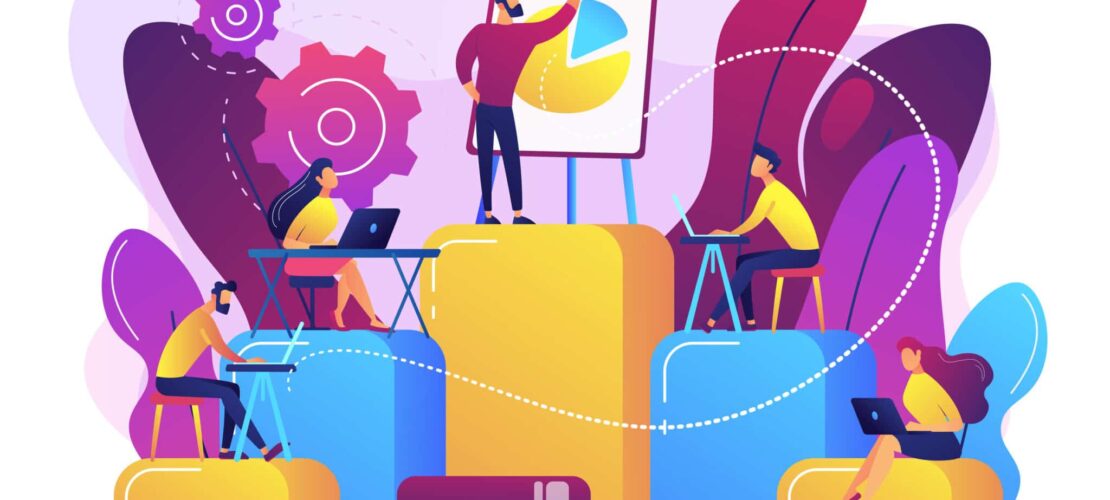Why Invest in Employee Development

Investing in employee development is not only a smart idea, but also what today’s top talent expects.
With Gen Z now starting to fill the ranks along with the mass of Millennials, today’s workers want learning and development as an integral component of their role with a company. Currently, Millennials make up the largest generation of the workforce. These generations have differing expectations of employers than their predecessors—where development was an optional perk or reserved for certain positions.
Yet, this isn’t to say that all generations in today’s workforce don’t seek development opportunities – they do.
In a 2019 study, LinkedIn’s Workforce Learning Report shared that 93% of employees would stay with a company should they invest in their professional career and development as an employee.
Unfortunately, well over 40% of organizations rarely provide career planning or professional employee development.
Then in early 2020, the pandemic hit.
Companies scrambled to keep employees safe while still managing business operations – or even to stay in business. The onset of the increased remote workforce accelerated the need for remote training and development.
And in spite of the pandemic, employers were still hiring. So how do you conduct onboarding training with a remote workforce? You train and develop through technology.
Organizations that previously hadn’t maximized their Learning Management System (LMS) platform were now doing so. Those without a comprehensive tool for employees to access training online, were seeking to expand how they deployed training and accessibility to all employees.
A robust LMS platform is a game-changer for Learning & Development and HR professionals to manage, create, disseminate, and analyze training for the organization.
Check out a recent blog: “Strategies for LMS Implementation and User Adoption.”
Employee Development vs. Employee Training
While we’re discussing why it’s a smart business strategy to invest in employee development, it’s probably helpful to call out the difference between training and development.
So, what’s the difference between employee training and employee development?
Employee training provides specific knowledge or skills for employees to do their job or improve performance. For the most part, training has specific goals related to employees’ current role and responsibilities.
Training can also include required information related to compliance, like safety, cyber security, or diversity training. In addition to skills and compliance training, training can help employees understand company policies or how to use new software.
Employee development is less about technical skills and knowledge. Rather, with long-term vision, development focuses on each employee’s individual growth, future performance, and career path.
Organizations committed to employee development uncover each person’s unique talents and strengths. Employee training can include structured training involving soft skills. Additionally, managers can develop staff through coaching, mentoring, and finding projects or roles to help them grow.
A company’s commitment to employee development signals that they value their people. They are truly interested in each employee’s personal success and growth. This goes beyond how well they do in their current role, but is evidence that leaders are vested in their development for the long haul.
Organizations that invest in employee development and instill a high-development culture value the growth of individuals. It is both beneficial to each individual but also the success and growth trajectory of the company.
Gallup found that organizations that have made strategic investment in employee development report 11% greater profitability and twice as likely to retain their employees.
Benefits of Investing in Employee Development

Higher Retention Rates
When an employee leaves an organization, the cost can be significant. A study found that when an employee leaves a company, the average cost is nearly 33% of that employee’s annual salary. This cost can quickly add up when you multiply the number of employees going out the front door.
Further, companies that do invest in employee development, typically have a 34% higher employee retention rate than companies that don’t.
On top of this, in today’s workforce, job seekers are passionate about working for a company that invests in employee development and committed to their personal and career growth. In fact, 54% of job seekers believe that employee development is more important than their salary.
Increased Engagement
It’s evident that the happiness of employees can positively, or negatively, impact a company’s bottom line. Recent studies have shown that, unhappy and disengaged employees cost the United States, in total, over $550 billion. The same study showed that an overwhelming 70% of employees are disengaged when at work.
Investing in employee development can contribute to an engaged workforce. On-going development can help prevent boredom, alleviate idleness, and establish a company culture that employees want to be a part of.
Additionally, when employees are more engaged at work, it leads to greater organizational success, ranging from increased productivity, efficiency, and profits.
Higher Profit Margins
Did you know that companies that invest in employee training and development reap a 24% higher profit margin than companies that don’t? On top of this, the American Society for Training and Development shared that, from 2500 firms in a study, there was a 218% higher income per employee with companies that invest in employee training and development. These numbers are significant.
Investing in an employee development program can lead to employees who are committed, dedicated, involved, and passionate about going to work and contributing to the growth of the organization.
Company Reputation and Image
One driving factor why a jobseeker will apply for a specific job with a company is because of the organization’s reputation. For example, Disney, is one of the world’s largest employers. Although the pandemic has significantly hit their employment ranks, Disney is a sought-after employer. Additionally, the organization has a reputation for being one of the best places to work for.
In the technology industry, such companies as Microsoft and Google are known for their commitment to employee training and development. Google’s approach to employee development goes further with an employee-to-employee training network called “g2” (Googler-to-Googler).
Companies that are known for a learning culture and commitment to employee training and development have an edge on other employers for obtaining top talent.
Succession Planning
An employee development program can help all individuals at all levels. However, a concerted effort to continually develop employees for the next step in the organization helps both employees and the company.
Succession planning is a strategic process with employee development efforts as the cornerstone to ensure a seamless transition of talent through the organization. Although succession planning is often thought to involve only top leadership positions, actually all major roles in an organization can benefit.
Smart organizations invest in employee development to cultivate future leaders. In addition to preparing for all contingencies, succession planning assists with knowledge transfer as individuals progress through the company. As part of an organization’s employee development efforts, connecting high-potential workers with willing mentors can assist with critical soft skills like communication, empathy, and diplomacy.
Preparing talent to fill key roles in an organization is critical to continuity of operations. Employee development efforts help keep employees engaged and motivated to excel. When top talent can see a path forward in a company, and are prepared for advancement, they are less likely to seek outside opportunities.
Attracting High Caliber Talent
Finding and attracting top-tier talent for an organization can often be challenging. In order to appeal to high performing talent, an organization needs to show the dedication to investing in employee development.
To appeal to prospective talent outside the organization, it’s smart to establish a comprehensive training and development program for the current workforce. All employees want to know and see that a company is genuine in their employee development efforts.
When employees feel valued, and have opportunities for personal growth, it strengthens the existing learning culture. News of an organization’s reputation and how well they treat their employees does get around. Engaged employees will spread the word and help communicate that the company is a great place to work, develop, and pursue a career path.
Competitive Edge
A comprehensive employee training and development program rightfully provides a competitive edge to an organization in their industry. Market leaders need the flexibility to innovate, expand, and be nimble in their approach to achieve growth and meet the needs of their customers.
Globalization is contributing to a tougher and more competitive economy. Staying a step ahead of the competition is imperative. An organization’s workforce is the soul of the company. There is connectivity between employees’ aptitude to innovate and the necessary space to develop and thrive.
Smart and strategic organizations invest in employee training and development. A high-quality training initiative will increase overall efficiency and productively and provide the desired competitive advantage.
Conclusion
At RTG Solutions Group, we understand the importance of employee development, and how it can positively impact a company. We help organizations navigate their workforce challenges, including developing comprehensive employee training and development programs.
Our expertise includes instructional design, compliance training, LMS implementation, employee onboarding, leadership development and specialized skills training. Commitment to employee learning leads to a stronger, more confident, and prosperous organization.
If your organization is searching for employee learning and development experts, or you have questions about how to optimize your efforts, contact us today!
